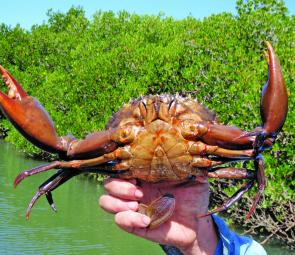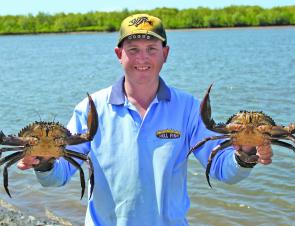Like most Queenslanders, soaking a few pots and chasing a few mud crabs is one recreational practice I thoroughly enjoy. Sure you have to deal with share farmers every now and then, but I never tire of the anticipation and feeling of pulling up a pot full of big angry bucks.
While crabbing may seem pretty simple it can actually be a bit more technical than many realise, as most consider size as the only factor determining take home catches. The 15cm legal size limit is vitally important, but just as much so is the quality of your crabs, as not all legal crabs will yield a tasty meal.
Often referred to as ‘floaters’, these sub-standard crabs are often quite large but are extremely light on as they have very little meat return, especially in their nippers and knuckles. They are so light they could almost float, hence the name, and when they are boiled they tend to float straight to the top.
Floaters crabs have recently shed their hard exoskeleton; therefore have little internal fat or muscle. While they may look impressive when you first pull up your pot, they are of little gain as they will return very little meat. They are best returned to the muddy water where they can begin filling out. Unfortunately, many inexperienced crabbers will fail to realise this as they often tip the contents of their pots straight into a bin or esky without a second thought. Nevertheless, there are a few ways to ‘grade’ the quality of your crabs without having to risk toes or fingers.
Colouration is the first big give away to the quality of your crab catch. Crabs that are ‘full’ are often very dark black when looking from above. This is because the crab has had time to feed and develop and fill into its exoskeleton. Light green on the other hand usually means the shell is relatively new and the crab has only recently shed, which means the crab is newly developed and is yet to fill out.
Additional, when you turn them over their colouration underneath gives you the best indicator of quality. If the underbelly of the crab has a brown rust colour then you have yourself a winner. The rustier the underneath of a crab the better quality. Many crabbers use the term ‘rusty bucks’, and some crabs are so rusty they are almost red underneath, which is a sign that they are at their peak and have been caught just prior to shedding.
Rusty crabs have very strong exoskeletons and really take some piercing with a knife when dispatching for cooking. They can be so full at times that the meat needs to be scooped out of the nippers as it is so firmly pressed against the shell. Some crabbers actually dislike these crabs are they have little fat (white creamy liquid) and all muscle which makes them less tasty almost like a good piece of steak. Crabs that have a clean white or blue hue colouration are a sign of a fresh shell and poor quality.
Another sign that can indicate good quality is the presence of a brown cross-like symbol that appears just above the abdomen (the pointy shape is male, rounded is female). If this cross is fully formed and quite pronounced then you are looking at a very good quality crab. If the symbol is partly formed, it usually indicates that the crab is still of good quality but not bursting at the seams.
Colouration is an easy way to grade a muddy, however, sometimes it can be a little deceiving. Crabs that have been living in sandy or weedy areas away from the mud can change in colouration, which sees the shell retain a light green colouration or no rust colour at all. In fact I have often caught crabs out on the flats that have been stained green by weed and even purple by coral! If you really want to take no chances on checking for quality there is one tried and tested method which never fails. Using your thumb and pointer finger pinch the area on the edge of carapace (top shell of the crab) near the measurement point. If the crab is empty or a ‘floater’ this area will be hollow allowing you to push into the shell with ease. If the crab is full or semi full this will be solid and strong with no give at all.
There are other basic giveaways as well, which include crabs with only one nipper or no nippers, or crabs with extremely soft shells.
Whichever method you use, checking the quality of your mud crab catch is important, as taking home empty crabs will yield very little return. So next time you find yourself up a creek and chasing a few mud crabs make sure you take just as much time checking quality as you would with size. Happy crabbing!
Helpful tips to consider when crabbing:
1. Have quality bait boxes that keep crabs or fish from stealing your bait. If crabs or fish have too much access to your bait they will quickly deplete it, which obviously lessens the chance of attracting more crabs to your pot. Metal bait boxes that use 1” heavy mesh or even PVC tubes with holes drilled into the sides are ideal.
2. Consider what you use for bait. Oily fish baits such as mullet or mackerel are ideal while cleaner flesh frames such as whiting and flathead are not particularly good. Try adding a small amount of beef heart and even a pilchard or two to your bait – you will be pleasantly surprised at the results!
3. Replace your bait every 6-12 hours. Crabs love fresh bait and fresh stuff will attract more crabs than old bait that has lost its smell.
4. Make sure wherever you are placing your pots there is plenty of mud around. They are not called mud crabs for nothing and the muddier the area the better. Keep an eye out at low tide as well for areas where crab holes are present. These are good spots to try.
5. Make sure you set your pots where water covers them at all tides, especially in the warmer months as crabs will die quickly in a pot with no coverage from the hot sun.
1
While this may look like a keeper crab, the white clean underbelly gives this crab away as being of poor quality and should be released.
2
This is a prime example of the colouration you would expect from a top quality full rusty buck.
3
Notice the rusty brown cross symbol above the abdomen of these crabs. This is a certain sign that quality will be top shelf.
4
What we all like to see; 3 legal bucks in a pot. However, on closer inspection one was a floater, can you tell which one?
5
Great haul of crabs and while quantity is always high on the list so should quality as well.
6
The best way to gauge the fullness of your crabs is to pinch the area near the corner of the carapace. If it’s hollow then it’s best to return the crab to the water.
Reads: 6426









